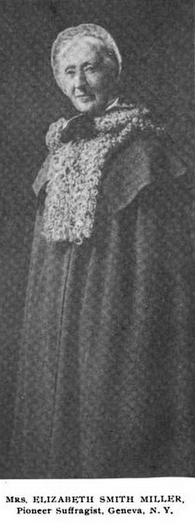Elizabeth Smith Miller

Elizabeth Smith Miller (September 20, 1822 – May 23, 1911), known as "Libby", was an American advocate and financial supporter of the women's rights movement.[1]
Biography[]
Elizabeth Miller was born September 20, 1822 in Peterboro, New York. She was the daughter of antislavery philanthropist Gerrit Smith and his spouse, the abolitionist Ann Carroll Fitzhugh. In 1843, Elizabeth married Charles Dudley Miller.[2] Elizabeth and Charles Dudley Miller occupied the "Cottage Across the Brook", on her father's estate at Peterboro, New York. It was later the home of their son, Gerrit Smith Miller. The family later moved to Geneva, New York,[3] where Miller died on May 23, 1911, aged 88.[4]
National Women's Right Convention[]
At the third National Women's Rights Convention gavelled in Syracuse, Smith Miller was the author of a motion to create State-based women's rights organizations when the motion to create a national organization failed. She was with Elizabeth Cady Stanton and Susan B. Anthony in the founding of the National Woman Suffrage Association.
Literary activity[]
Following her father's death in 1874, Elizabeth Smith Miller worked on a biography of his life along with author Octavius Brooks Frothingham. When Frothingham went so far as to allege that Smith had prior knowledge of John Brown's raid on Harper's Ferry, Elizabeth ordered the publisher to recall the tomes, break their bindings, and remove the information.[1] In her later years, Smith Miller penned a home economics treatise.[1]
Dress code reform[]
An advocate of Victorian dress reform, Elizabeth Smith Miller first wore the Turkish pantaloons and knee length skirt later popularized by Amelia Bloomer in The Lily. The apparel and its undergarment was similar to utilitarian outfits also worn by women of the utopian Oneida Community and the Oneida Nation's women.[1] Dress reform was seen as essential in liberating women from the functional constraints imposed on their activities by conventions reinforcing a male dominated society. "Bloomers" were worn by leaders of the women's rights movement as an act of rebellion until the amount of attention the protest received in the popular press became a distraction from the movement.[1]
Publications[]
- In the Kitchen, Boston: Lee and Shepard, 1875. full text available at the Library of Congress Archive.org Google Books
References[]
- ^ Jump up to: a b c d e NY History Net, "Elizabeth Smith Miller" (April 21, 2011).
- ^ Gerrit Smith Estate, National Historic Landmark Nomination, NPS Form 10-900 USDI/NPS NRHP Registriation Form (Rev. 8-86) OMB No. 1024-0018.
- ^ U.S. Department of the Interior, National Park Service, Elizabeth Smith Miller (April 15, 2011).
- ^ "Mrs. Elizabeth Smith Miller Dead Near Geneva". The Buffalo Times. Rochester. Associated Press. May 24, 1911. p. 12. Retrieved July 8, 2020 – via Newspapers.com.
External links[]
- Elizabeth Smith Miller and Anne Fitzhugh Miller NAWSA Suffrage Scrapbooks
- Webcast-Catch the Suffragist's Spirit: Miller Scrapbooks from the Library of Congress
- Carrie Chapman Catt Collection at the Library of Congress has volumes from the library of Elizabeth Smith Miller.
- In the Kitchen by Elizabeth Smith Miller. From the Katherine Golden Bitting Collection at the Library of Congress
- 1842 births
- 1911 deaths
- American abolitionists
- American suffragists
- People from Geneva, New York
- Women civil rights activists